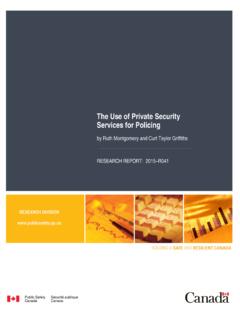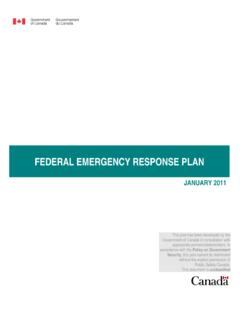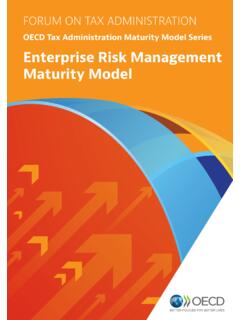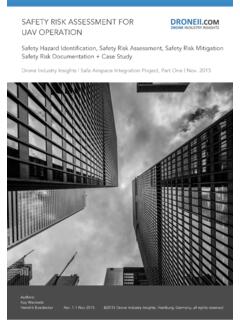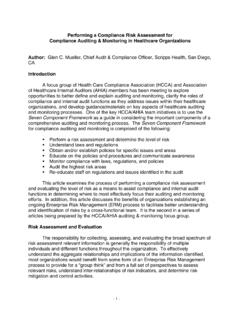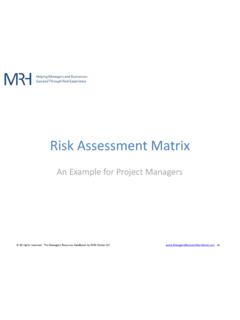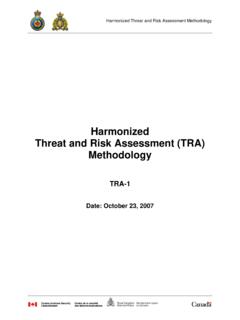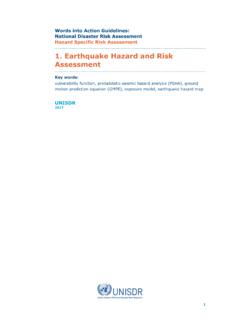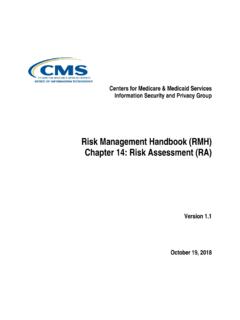Transcription of Risk-Need-Responsivity Model for Offender Assessment and ...
1 Risk-Need-Responsivity Model for Offender Assessment and Rehabilitation 2007-06 James Bonta Public Safety Canada D. A. Andrews Carleton University Her Majesty the Queen in Right of Canada, 2007 Cat. No.: PS3-1/2007-6 ISBN No.: 978-0-662-05049-0 Acknowledgement We would like to acknowledge the critical comments and support provided by Annie Yessine in the preparation of this report. The opinions expressed in this report are those of the authors and do not necessarily represent the views of Public Safety Canada.. Table of Contents Abstract .. i 1 A brief history of risk Assessment .
2 3 First generation: Professional judgement .. 3 Second generation: Evidence-based tools .. 3 Third generation: Evidence-based and dynamic .. 4 Fourth generation: Systematic and 4 Risk-Need-Responsivity Model and Offender risk 5 Offender 9 Brief history of Offender rehabilitation .. 9 The RNR Model and Offender 9 Generality of the RNR 13 Summary and conclusions .. 15 19 Abstract Developed in the 1980s and first formalized in 1990, the Risk-Need-Responsivity Model has been used with increasing success to assess and rehabilitate criminals in Canada and around the world.
3 As suggested by its name, it is based on three principles: 1) the risk principle asserts that criminal behaviour can be reliably predicted and that treatment should focus on the higher risk offenders; 2) the need principle highlights the importance of criminogenic needs in the design and delivery of treatment; and 3) the responsivity principle describes how the treatment should be provided. This paper summarizes the role of the principles in the development of risk Assessment instruments. It also explains why some interventions work and others do not. i Introduction The Risk-Need-Responsivity (RNR) Model is perhaps the most influential Model for the Assessment and treatment of offenders (Blanchette & Brown, 2006; Ward, Mesler & Yates, 2007).
4 First formalized in 1990 (Andrews, Bonta & Hoge), the RNR Model has been elaborated upon and contextualized within a general personality and cognitive social learning theory of criminal conduct (Andrews & Bonta, 2006). Since 1990, a number of principles have been added to the core theoretical principles to enhance and strengthen the design and implementation of effective interventions. These additional principles describe, for example, the importance of staff establishing collaborative and respectful working relationships with clients and correctional agencies and managers providing policies and leadership that facilitate and enable effective interventions (Andrews, 2001; Andrews & Bonta, 2006; Andrews & Dowden, in press).
5 Although we should not lose sight of the full set of principles (we will say a bit more about them at the end of the paper) our focus here will be with the core principles of risk, need and responsivity. Briefly, the three core principles can be stated as follows: Risk principle: Match the level of service to the Offender s risk to re-offend. Need principle: Assess criminogenic needs and target them in treatment. Responsivity principle: Maximize the Offender s ability to learn from a rehabilitative intervention by providing cognitive behavioural treatment and tailoring the intervention to the learning style, motivation, abilities and strengths of the Offender .
6 There are two parts to the responsivity principle: general and specific responsivity. General responsivity calls for the use of cognitive social learning methods to influence behaviour. Cognitive social learning strategies are the most effective regardless of the type of Offender ( , female Offender , Aboriginal Offender , psychopath, sex Offender ). Core correctional practices such as prosocial modeling, the appropriate use of reinforcement and disapproval, and problem solving (Dowden & Andrews, 2004) spell out the specific skills represented in a cognitive social learning approach. Specific responsivity is a fine tuning of the cognitive behavioural intervention.
7 It takes into account strengths, learning style, personality, motivation, and bio-social ( , gender, race) characteristics of the individual. This paper summarizes how the RNR Model has influenced development of Offender risk Assessment instruments and Offender rehabilitation programs. In so doing, we provide a summary of the evidence that demonstrates how the criminal behaviour of offenders can be predicted in a reliable, practical and useful manner. We also provide evidence of how rehabilitation programs can produce significant reductions in recidivism when these programs are in adherence with the RNR Model . 1 A brief history of risk Assessment First generation: Professional judgement For much of the first half of the twentieth century, the Assessment of Offender risk was left in the hands of correctional staff ( , probation officers and prison staff) and clinical professionals ( , psychologists, psychiatrists and social workers).
8 Guided by their own professional training and experience, staff would make judgements as to who required enhanced security and supervision. The Assessment of risk was a matter of professional judgement. Second generation: Evidence-based tools Beginning in the 1970s there was a growing recognition that the Assessment of risk needed to depend more upon actuarial, evidence-based science and less on professional judgement. Actuarial risk Assessment instruments consider individual items ( , history of substance abuse) that have been demonstrated to increase the risk of reoffending and assign these items quantitative scores.
9 For example, the presence of a risk factor may receive a score of one and its absence a score of zero. The scores on the items can then be summed the higher the score, the higher the risk that the Offender will reoffend. Some notable examples of the actuarial risk Assessment scales that were developed during this period are the Salient Factor Score developed in the United States (Hoffman & Beck, 1974) and the Statistical Information on Recidivism scale developed for the Correctional Service of Canada (Nuffield, 1982). These risk Assessment instruments are still used today and new ones continue to be developed (Copas & Marshall, 1998).
10 Before long it became clear that these actuarial risk Assessment instruments were better at predicting criminal behaviour than professional judgement. Research reviews repeatedly showed that actuarial instruments performed better than clinical or professional judgement when making predictions of human behaviour ( gisd ttier, White, Spengler et al., 2006; Andrews, Bonta & Wormith, 2006; Grove, Zald, Lebow, Snitz Nelson, 2000). The superiority of actuarial prediction has been extended to such diverse Offender groups as mentally disordered offenders (Bonta, Law & Hanson, 1998) and sex offenders (Hanson & Bussi re, 1998).


